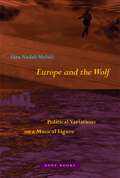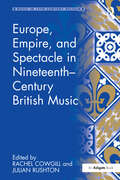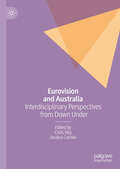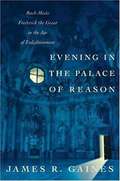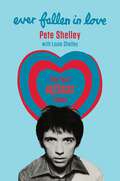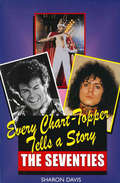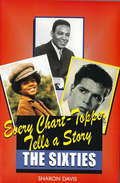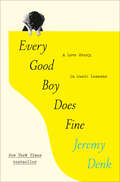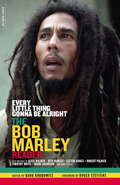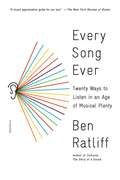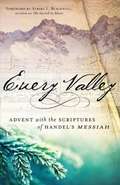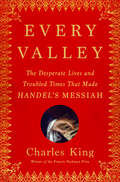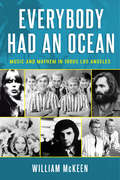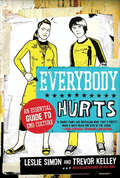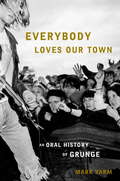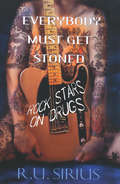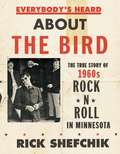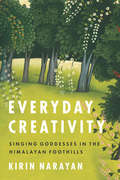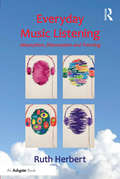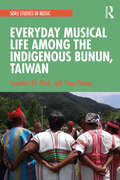- Table View
- List View
Europe and the Wolf: Political Variations on a Musical Figure
by Sara Nadal-MelsióHow the work of several contemporary artists illuminates and challenges the policing of European borders and identityIn this stunningly original book, Sara Nadal-Melsió explores how the work of several contemporary artists illuminates the current crisis of European universalist values amid the brutal realities of exclusion and policing of borders. The &“wolf&” is the name Baroque musicians gave to the dissonant sound produced in any attempt to temper and harmonize an instrument. Europe and the Wolf brings this musical figure to bear on contemporary aesthetic practices that respond to Europe&’s ongoing social and political contradictions. Throughout, Nadal-Melsió understands Europe as a conceptual problem that often relies on harmonization as an organizing category. The &“wolf&” as an emblem of disharmony, incarnated in the stranger, the immigrant, or the refugee, originates in the Latin proverb &“man is a wolf to man.&” This longstanding phrase evokes the pervasive fear, and even hatred, of what is foreign, unknown, or beyond the borders of a community. The book follows the &“wolf&” in a series of relays between the musical, the visual, and the political, and through innovative readings of artworks—by, among others, Carles Santos, Pere Portabella, Allora&Calzadilla, and Anri Sala. Traversed by the musical, these artworks, as well as Nadal-Melsió&’s writing, present unstable symbolic and material ensembles in an array of variations of political possibilities and impossibilities that evade institutions intolerant of uncertainty and wary of diversity.
Europe, Empire, and Spectacle in Nineteenth-Century British Music (Music In Nineteenth-century Britain Ser.)
by Julian RushtonThis volume illuminates musical connections between Britain and the continent of Europe, and Britain and its Empire. The seldom-recognized vitality of musical theatre and other kinds of spectacle in Britain itself, and also the flourishing concert life of the period, indicates a means of defining tradition and identity within nineteenth-century British musical culture. The objective of the volume has been to add significantly to the growing literature on these topics. It benefits not only from new archival research, but also from fresh musicological approaches and interdisciplinary methods that recognize the integral role of music within a wider culture, including religious, political and social life. The essays are by scholars from the USA, Britain, and Europe, covering a wide range of experience. Topics range from the reception of Bach, Mozart, and Liszt in England, a musical response to Shakespeare, Italian opera in Dublin, exoticism, gender, black musical identities, British musicians in Canada, and uses of music in various theatrical genres and state ceremony, and in articulating the politics of the Union and Empire.
Eurovision and Australia: Interdisciplinary Perspectives from Down Under
by Chris Hay Jessica CarnielThis book investigates Australia’s relationship with the Eurovision Song Contest over time and place, from its first screening on SBS in 1983 to Australia's inaugural national selection in 2019. Beginning with an overview of Australia’s Eurovision history, the contributions explore the contest’s role in Australian political participation and international relations; its significance for Australia’s diverse communities, including migrants and the LGBTQIA+ community; racialised and gendered representations of Australianness; changing ideas of liveness in watching the event; and a reflection on teaching Australia’s first undergraduate course dedicated to the Eurovision Song Contest. The collection brings together a group of scholar-fans from a variety of interdisciplinary perspectives — including history, politics, cultural studies, performance studies, and musicology — to explore Australia’s transition from observer to participant in the first thirty-six years of its love affair with the Eurovision Song Contest.
Evanira Mendes: A Voice from the Brazilian Folklore Movement
by Eric A. GalmThis compilation of Evanira Mendes’s biography and translated publications offers for the first time in English an opportunity to revisit the music and culture of 1950s Brazil. Examining the trajectory of the Brazilian folklore movement, this book provides a new perspective on contemporary accounts that have overlooked the participation of women scholars from that era and seeks to grant Mendes the recognition she so richly deserves. Growing up on a farm in rural São Paulo State, Evanira Mendes (1929–2022) exhibited an early love of folklore, cultivated through the stories, songs, and gossip of wandering travelers in exchange for food and shelter. As she got older, she entered the Conservatório Dramático e Musical de São Paulo to study piano, but her love of folklore persisted, and she was invited to work in the school’s folklore archive and later as a folklore researcher for the São Paulo Folklore Commission from 1949 to 1959. There, she won awards including the national Sílvio Romero Medal; won second place in a national folklore monograph competition; helped to organize the folklore pavilion at the IV° Centenário de São Paulo celebration; and worked closely with important names of the era. Despite these accomplishments, she has essentially been forgotten. This book follows Evanira Mendes’s experiences working as a field researcher as part of the São Paulo Folklore Commission, her participation and organization at national and international folklore conferences, her participatory research in Afro-Brazilian community dances and observation and critique of Brazilian modern artistic expression in the theaters of São Paulo, and her work as editor of the folklore page and later weekly columnist in the Correio Paulistano newspaper. Her first-person accounts of fieldwork and participation in folklore courses are supplemented by separate published accounts from various sources, helping to compile a comprehensive portrait of music and culture in São Paulo and Brazil from that era.
Evening in the Palace of Reason
by James R. GainesFrederick The Great had a conflicted youth. His mother taught him to love art, luxury and intrigue. His father beat him mercilessly and often as he trained his son to be a dedicated leader and warrior. Bach knew and was fulfilled by his lifelong career as a brilliant composer and performer, though he often felt that he was underpaid and that the work he so loved wasn't appreciated. This historic novel illuminates the motives and goals of these major figures in the age of enlightenment. Fascinating and challenging facts about music and history abound. The novel is followed by a discography guiding the reader to J. S. Bach's recordings.
Ever Fallen in Love: The Lost Buzzcocks Tapes
by Pete Shelley Louie Shelley***'Lots of great stories... A fascinating insight.'-JOHN MAHER, Buzzcocks'Perfectly executed, highly detailed, incredibly interesting.'-HENRY ROLLINS, Black Flag'Pete and Buzzcocks were there right from the beginning.'-BERNARD SUMNER, Joy Division, New Order When Pete Shelley, lead singer of legendary punk band Buzzcocks, passed away in 2018 we lost the chance to hear one of music's brightest stars tell his story.Or so it seemed.Now, recordings have surfaced of a series of remarkable interviews in which Pete tells the story of his life, his band and his place at the beating heart of the punk explosion in fascinating detail.Recorded over a series of late-night calls with a close friend, the tapes hear Pete talk song-by-song through Buzzcocks releases to reveal the personal memories behind the music and the inspiration for masterpieces such as 'Ever Fallen in Love (With Someone You Shouldn't've)' and 'What Do I Get?'.Published for the first time and with the blessing of Pete's estate, Ever Fallen In Love: The Lost Buzzcocks Tapes is a tribute to a founding member of punk and a chance to hear one of music's true visionaries tell his own story at last.'A true gentleman and a great artist and songwriter.'-PETER HOOK, Joy Division, New Order 'Shot through with self-doubt and mild regret, Pete Shelley's lovesick pop classics have a bittersweet charm that will forever speak to the young romantic'-JOHN COOPER CLARKE'Buzzcocks were the blue touchpaper for my love of music. Pure pop met punk and the result was perfection.'-TIM BURGESS, The Charlatans
Ever Fallen in Love: The Lost Buzzcocks Tapes
by Pete Shelley Louie Shelley***'Lots of great stories... A fascinating insight.'-JOHN MAHER, Buzzcocks'Perfectly executed, highly detailed, incredibly interesting.'-HENRY ROLLINS, Black Flag'Pete and Buzzcocks were there right from the beginning.'-BERNARD SUMNER, Joy Division, New Order When Pete Shelley, lead singer of legendary punk band Buzzcocks, passed away in 2018 we lost the chance to hear one of music's brightest stars tell his story.Or so it seemed.Now, recordings have surfaced of a series of remarkable interviews in which Pete tells the story of his life, his band and his place at the beating heart of the punk explosion in fascinating detail.Recorded over a series of late-night calls with a close friend, the tapes hear Pete talk song-by-song through Buzzcocks releases to reveal the personal memories behind the music and the inspiration for masterpieces such as 'Ever Fallen in Love (With Someone You Shouldn't've)' and 'What Do I Get?'.Published for the first time and with the blessing of Pete's estate, Ever Fallen In Love: The Lost Buzzcocks Tapes is a tribute to a founding member of punk and a chance to hear one of music's true visionaries tell his own story at last.'A true gentleman and a great artist and songwriter.'-PETER HOOK, Joy Division, New Order 'Shot through with self-doubt and mild regret, Pete Shelley's lovesick pop classics have a bittersweet charm that will forever speak to the young romantic'-JOHN COOPER CLARKE'Buzzcocks were the blue touchpaper for my love of music. Pure pop met punk and the result was perfection.'-TIM BURGESS, The Charlatans
Every Chart Topper Tells a Story: The Seventies
by Sharon DavisThe seventies witnessed great changes not only in dress style but also in music. The psychedelia of the late sixties had mutated into glam rock by the early seventies, while the latter half of the decade is best remembered for the punk and disco explosions which gripped both Britain and America. The number-one singles of the decade are recalled in Every Chart Topper Tells a Story: The Seventies, from artists as diverse as Gary Glitter, David Bowie, Jimi Hendrix, Diana Ross, The Bee Gees, T-Rex, Commodores, Donny Osmond, The Three Degrees and Abba. It is the ideal volume both for those wanting a trip down memory lane and for serious music connoisseurs.
Every Chart Topper Tells a Story: The Sixties
by Sharon DavisThe glorious sixties were a decade for the young and rebellious, of cultural freedom and of sexual liberation. The British music scene had never been so adventurous, taking even the American charts by storm.Every Chart-Topper Tells a Story: The Sixties takes a look at the number-one hit singles of the decade in Britain from artists such as The Rolling Stones, The Beatles, Elvis Presley, Dusty Springfield, Ken Dodd, Cilla Black, The Supremes, Cliff Richard and Helen Shapiro, and is a valuable and entertaining source of information for all those interested in the sixties' music scene.
Every Good Boy Does Fine: A Love Story, in Music Lessons
by Jeremy DenkA beautifully written, witty memoir that is also an immersive exploration of classical music—its power, its meanings, and what it can teach us about ourselves—from the MacArthur "Genius" Grant-winning pianist&“Jeremy Denk has written a love letter to the music, and especially to the music teachers, in his life.&”—Conrad Tao, pianist and composer In Every Good Boy Does Fine, renowned pianist Jeremy Denk traces an implausible journey. His life is already a little tough as a precocious, temperamental six-year-old piano prodigy in New Jersey, and then a family meltdown forces a move to New Mexico. There, Denk must please a new taskmaster, an embittered but devoted professor, while navigating junior high school. At sixteen he escapes to college in Ohio, only to encounter a bewildering new cast of music teachers, both kind and cruel. After many humiliations and a few triumphs, he ultimately finds his way as a world-touring pianist, a MacArthur &“Genius,&” and a frequent performer at Carnegie Hall. Many classical music memoirs focus on famous musicians and professional accomplishments, but this book focuses on the everyday: neighborhood teacher, high school orchestra, local conductor. There are few writers capable of so deeply illuminating the trials of artistic practice—hours of daily repetition, mystifying advice, pressure from parents and teachers. But under all this struggle is a love letter to the act of teaching. In lively, endlessly imaginative prose, Denk dives deeply into the pieces and composers that have shaped him—Bach, Mozart, and Brahms, among others—and offers lessons on melody, harmony, and rhythm. How do melodies work? Why is harmony such a mystery to most people? Why are teachers so obsessed with the metronome?In Every Good Boy Does Fine, Denk shares the most meaningful lessons of his life, and tries to repay a debt to his teachers. He also reminds us that we must never stop asking questions about music and its purposes: consolation, an armor against disillusionment, pure pleasure, a diversion, a refuge, and a vehicle for empathy.
Every Little Step: My Story
by Nick Chiles Bobby BrownA New York Times BestsellerIn Every Little Step, Bobby Brown tells the full story of his life and sets the record straight, particularly about his relationship with Whitney Houston.Bobby Brown has been one of the most compelling American artists of the past thirty years, a magnetic and talented figure who successfully crossed over many musical genres, including R&B and hip hop, as well as the mainstream. In the late 1980s, the former front man of New Edition had a wildly successful solo career—especially with the launch of Don't Be Cruel—garnering multiple hits on the Billboard top ten list, as well as several Grammy, American Music, and Soul Train awards. But Brown put his career on hold to be with the woman he loved—American music royalty Whitney Houston. The marriage between Brown and Houston was perhaps the most closely watched and talked about marriage of the 1990s—a pairing that obsessed the public and the gossip industry. Now, for the first time, the world will be able to hear the truth from the mouth of America’s “bad boy” himself. Raw and powerful, Every Little Step is the story of a man who has been on the top of the mountain and in the depths of the valley and who is now finally ready to talk about his career and family life, from the passion and the excess to his creative inspirations and massive musical success.On the process of writing this book, Bobby says, “Right after I signed on to write my story, I went through one of the most agonizing traumas I had ever experienced with the death of my daughter. But I was surprised by how therapeutic it was to work on this project, to look at the entire arc of my life and to realize that although there has been considerable pain, I have also been incredibly blessed. I hope my fans and other readers of this book will be entertained by this trip into the crazy, exciting, fascinating world of Bobby Brown. And I hope they will feel that I have been as honest and open with them in these pages as I have tried to be my entire life.”
Every Little Thing Gonna Be Alright: The Bob Marley Reader
by Hank BordowitzThroughout Africa, the Caribbean, Europe, and America, Bob Marley represents far more than just the musician who translated spiritual and political beliefs into hypnotic, hard-hitting songs such as "Get Up, Stand Up," "No Woman, No Cry," and "Jammin'. " Marley was born in rural Jamaica and reared in the mean streets of Kingston's Trenchtown; his ascent to worldwide acclaim, first with The Wailers--Peter Tosh and Bunny Livingstone--and later as a solo artist, is a riveting story of the spiritual awakening of a uniquely talented individual. Now, for the first time, a symphony of voices has joined together to offer perspective on one of this century's most compelling figures. Dealing with Bob Marley as a man and myth, from his "rude boy" teens to international fame and his tragic death at the age of thirty-six, Every Little Thing Gonna Be Alright then explores the larger picture, examining Marley as the spokesman for Jamaica's homegrown religion of Rastafarianism, as a flash point for the pressure cooker of Jamaican politics, and his unique status as the first pop musical superstar of the so-called "Third World. "
Every Song Ever: Twenty Ways to Listen in an Age of Musical Plenty, First edition
by Ben RatliffWhat does it mean to listen in the digital era? Today, we can listen to nearly anything, at any time, from Detroit techno to jam bands to baroque opera. The possibilities in this new age of listening overturn old assumptions about what it means to properly appreciate music---to be an “educated” listener. In Every Song Ever, veteran New York Times music critic Ben Ratliff reimagines the very idea of music appreciation in this day and age. As familiar subdivisions like “rock” and “jazz” matter less and less and music’s accessible past becomes longer and broader, listeners can put aside the intentions of composers and musicians and engage music afresh, on their own terms. The result is a new mode of listening that can lead to unexpected connections and astonishing possibilities---as well as dangers. <P><P>Encompassing the sounds of five continents and several centuries, Every Song Ever is a necessary field guide to our musical habitat, and a foundation for the new aesthetics our age demands.
Every Valley
by George Frideric HandelGeorge Frederic Handel wrote his most famous oratorio, Messiah, in a little over three weeks. There is little doubt that this work is one of the most famous and often performed choral pieces in history. Handel conducted many performances in his day and there never seemed to have been a period when the work was not played. These selections feature the tenor voice of the quintet - the euphonium (or trombone).
Every Valley: The Desperate Lives and Troubled Times That Made Handel's Messiah
by Charles KingNEW YORK TIMES NOTABLE BOOK • NEW YORK TIMES BOOK REVIEW EDITORS' CHOICE • From the bestselling historian and National Book Critics Circle Award finalist, the moving untold story of the eighteenth-century men and women behind the making of Handel&’s Messiah."A delicious history of music, power, love, genius, royalty and adventure."—Simon Sebag Montefiore, author of The World"A book of power and glory, brimming with emotion and dazzling in its reach."—Stacy Schiff, Pulitzer Prize-winning author of Cleopatra and The RevolutionaryGeorge Frideric Handel&’s Messiah is arguably the greatest piece of participatory art ever created. Adored by millions, it is performed each year by renowned choirs and orchestras, as well as by audiences singing along with the words on their cell phones.But this work of triumphant joy was born in a worried age. Britain in the early Enlightenment was a place of astonishing creativity but also the seat of an empire mired in war, enslavement, and conflicts over everything from the legitimacy of government to the meaning of truth. Against this turbulent background, prize-winning author Charles King has crafted a cinematic drama of the troubled lives that shaped a masterpiece of hope.Every Valley presents a depressive dissenter stirred to action by an ancient prophecy; an actress plagued by an abusive husband and public scorn; an Atlantic sea captain and penniless philanthropist; and an African Muslim man held captive in the American colonies and hatching a dangerous plan for getting back home. At center stage is Handel himself, composer to kings but, at midlife, in ill health and straining to keep an audience&’s attention. Set amid royal intrigue, theater scandals, and political conspiracy, Every Valley is entertaining, inspiring, unforgettable.
Everybody Had an Ocean: Music and Mayhem in 1960s Los Angeles
by William MckeenLos Angeles in the 1960s gave the world some of the greatest music in rock 'n' roll history: "California Dreamin'" by the Mamas and the Papas, "Mr. Tambourine Man" by the Byrds, and "Good Vibrations" by the Beach Boys, a song that magnificently summarized the joy and beauty of the era in three and a half minutes.But there was a dark flip side to the fun fun fun of the music, a nexus between naive young musicians and the hangers-on who exploited the decade's peace, love, and flowers ethos, all fueled by sex, drugs, and overnight success. One surf music superstar unwittingly subsidized the kidnapping of Frank Sinatra Jr. The transplanted Texas singer Bobby Fuller might have been murdered by the Mob in what is still an unsolved case. And after hearing Charlie Manson sing, Neil Young recommended him to the president of Warner Bros. Records. Manson's ultimate rejection by the music industry likely led to the infamous murders that shocked a nation.Everybody Had an Ocean chronicles the migration of the rock 'n' roll business to Southern California and how the artists flourished there. The cast of characters is astonishing—Brian and Dennis Wilson of the Beach Boys, Jan and Dean, eccentric producer Phil Spector, Cass Elliot, Sam Cooke, Ike and Tina Turner, Joni Mitchell, and scores of others—and their stories form a modern epic of the battles between innocence and cynicism, joy and terror. You'll never hear that beautiful music in quite the same way.
Everybody Hurts: An Essential Guide to Emo Culture
by Trevor Kelley Leslie SimonWhat is emo? For starters it's a form of melodic, confessional, or EMOtional punk rock. But emo is more than a genre of music–it's the defining counterculture movement of the '00s. EVERYBODY HURTS is a reference book for emo, tracing its angsty roots all the way from Shakespeare to Holden Caufield to today's most popular bands. There's nothing new about that perfect chocolate and peanut butter combination––teenagers and angst. What is new is that emo is the first cultural movement born on the internet. With the development of early social networking sites like Make Out Club (whose mission is to unite "like–minded nerds, loners, indie rockers, record collectors, video gamers, hardcore kids, and artists through friendship, music, and sometimes even love") outcast teens had a place to find each other and share their pain, their opinions, and above all, their music–which wasn't available for sale at the local record store. Authors Leslie Simon and Trevor Kelley lead the reader through the world of emo including its ideology, music, and fashion, as well as its influences on film, television, and literature. With a healthy dose of snark and sarcasm, EVERYBODY HURTS uses diagrams, illustrations, timelines, and step–by–step instructions to help the reader successfully achieve the ultimate emo lifestyle. Or, alternately, teach him to spot an emo kid across the mall in order to mock him mercilessly.
Everybody Loves Our Town: A History of Grunge
by Mark YarmTwenty years after the release of Nirvana's landmark album Nevermind comes Everybody Loves Our Town: An Oral History of Grunge, the definitive word on the grunge era, straight from the mouths of those at the center of it all. In 1986, fledgling Seattle label C/Z Records released Deep Six, a compilation featuring a half-dozen local bands: Soundgarden, Green River, Melvins, Malfunkshun, the U-Men and Skin Yard. Though it sold miserably, the record made music history by documenting a burgeoning regional sound, the raw fusion of heavy metal and punk rock that we now know as grunge. But it wasn't until five years later, with the seemingly overnight success of Nirvana's "Smells Like Teen Spirit," that grunge became a household word and Seattle ground zero for the nineties alternative-rock explosion.Everybody Loves Our Town captures the grunge era in the words of the musicians, producers, managers, record executives, video directors, photographers, journalists, publicists, club owners, roadies, scenesters and hangers-on who lived through it. The book tells the whole story: from the founding of the Deep Six bands to the worldwide success of grunge's big four (Nirvana, Pearl Jam, Soundgarden and Alice in Chains); from the rise of Seattle's cash-poor, hype-rich indie label Sub Pop to the major-label feeding frenzy that overtook the Pacific Northwest; from the simple joys of making noise at basement parties and tiny rock clubs to the tragic, lonely deaths of superstars Kurt Cobain and Layne Staley. Drawn from more than 250 new interviews--with members of Nirvana, Pearl Jam, Soundgarden, Alice in Chains, Screaming Trees, Hole, Melvins, Mudhoney, Green River, Mother Love Bone, Temple of the Dog, Mad Season, L7, Babes in Toyland, 7 Year Bitch, TAD, the U-Men, Candlebox and many more--and featuring previously untold stories and never-before-published photographs, Everybody Loves Our Town is at once a moving, funny, lurid, and hugely insightful portrait of an extraordinary musical era.From the Hardcover edition.
Everybody Must Get Stoned: Rock Stars On Drugs
by R. U. SiriusKeith's on guitar, Charlie's on drums, and Ronnie's on rhythm. But who's on drugs? Everybody.Welcome to the red-eyed world of rock and roll, where every riff comes with a spliff--a coked-up compendium of your favorite musicians and their favorite drugs. Loaded with sordid tales of debauchery, lists, and bleary-eyed photos, there's more stuff in here than in one of Snoop Dogg's favorite brownies, including: * The Top Ten Albums to Tweak to * The Top Ten Rock Star Drug Quotes * The Top Ten Drug Busts in Rock * Extreme acid casualties * Outrageous drug stories of rock legends * The secret history of Dylan and drugs * Henry Rollins and Frank Zappa: How to act like you're on drugs without actually doing any * And the answer to the ever popular rock and roll drug question, "Who gave the Beatles their first hits of acid?" (Their dentist!)So put on your favorite CD, don't try the green acid, and enjoy! Note: Pages are not suitable for rolling papers. R. U. Sirius (aka Ken Goffman) is the co-editor of 10 Zen Monkeys and the host of two weekly podcasts, "The R.U. Sirius Show" and "Neo-Files with R. U. Sirius." He has worked as a columnist for ArtForum International and The San Francisco Examiner. He has written for Time, Esquire, Wired, and Boing Boing. He is the author of CounterCulture Through the Ages: From Abraham to Acid House, How to Mutate and Take Over the World, and The CyberPunk Handbook, and co-author of Design for Dying with Timothy Leary. He lives in Mill Valley, California.
Everybody was Kung-fu Dancing: Chronicles of the Lionized and the Notorious
by Chet FlippoA collection of magazine articles, many from the Rolling Stone, by the American music journalist and biographer Chet Flippo, mostly from the 1980s. People covered or interviewed include: John Lennon, Al Green, Tony Bennett, Les Paul, Chet Atkins, Bobby Bare, Bill Haley, Phil Ochs, David Geffen, Jimmy Buffett, Elvis, Mick Jagger,, Willie Nelson, Waylon Jennings.
Everybody's Doin' It: Sex, Music, And Dance In New York, 1840-1917
by Dale Cockrell"Racy scholarship does the Grizzly Bear here with theoretical rigor." —William Lhamon, author of Raising Cain Everybody’s Doin’ It is the eye-opening story of popular music’s seventy-year rise in the brothels, dance halls, and dives of New York City. It traces the birth of popular music, including ragtime and jazz, to convivial meeting places for sex, drink, music, and dance. Whether coming from a single piano player or a small band, live music was a nightly feature in New York’s spirited dives, where men and women, often black and white, mingled freely—to the horror of the elite. This rollicking demimonde drove the development of an energetic dance music that would soon span the world. The Virginia Minstrels, Juba, Stephen Foster, Irving Berlin and his hit “Alexander’s Ragtime Band,” and the Original Dixieland Jass Band all played a part in popularizing startling new sounds. Musicologist Dale Cockrell recreates this ephemeral underground world by mining tabloids, newspapers, court records of police busts, lurid exposés, journals, and the reports of undercover detectives working for social-reform organizations, who were sent in to gather evidence against such low-life places. Everybody’s Doin’ It illuminates the how, why, and where of America’s popular music and its buoyant journey from the dangerous Five Points of downtown to the interracial black and tans of Harlem.
Everybody's Heard about the Bird: The True Story of 1960s Rock 'n' Roll in Minnesota
by Rick ShefchikIf you didn&’t experience rock and roll in Minnesota in the 1960s, this book will make you wish you had. This behind-the-scenes, up-close-and-personal account relates how a handful of Minnesota rock bands erupted out of a small Midwest market and made it big. It was a brief, heady moment for the musicians who found themselves on a national stage, enjoying a level of success most bands only dream of.In Everybody&’s Heard about the Bird, Rick Shefchik writes of that time in vivid detail. Interviews with many of the key musicians, combined with extensive research and a phenomenal cache of rare photographs, reveal how this monumental era of Minnesota rock music evolved. The chronicle begins with musicians from the 1950s and early 1960s, including Augie Garcia, Bobby Vee, the Fendermen, and Mike Waggoner and the Bops. Shefchik looks at how a local recording studio and record label, along with Minnesota radio stations, helped make their achievements possible and prepared the way for later bands to break out nationally. Shefchik delves deeply into the Trashmen&’s emblematic rise to fame. A Minneapolis band that recorded a fluke novelty hit called &“Surfin&’ Bird&” at Kay Bank Studios, the Trashmen signed with Soma Records, topped the local charts in late 1963, and were poised to top the national charts in early 1964. Hundreds of Minnesota bands took inspiration from the Trashmen&’s success, as teen dances with live bands flourished in clubs, ballrooms, gyms, and halls across the Upper Midwest. Here are the stories of bands like the Gestures, the Castaways, and the Underbeats, and the triumphs—and tragedies—of the most prominent Minnesota-spawned bands of the late 1960s, including Gypsy, Crow, and the Litter.For the baby boomers who remember it and everyone else who has felt its influence, the 1960s rock-and-roll scene in Minnesota was an extraordinary period both in musical history and popular culture, and now it&’s captured fully in print for the first time. Everybody&’s Heard about the Bird celebrates how these bands found their singular sound and played for their elated audiences from the golden era to today.
Everyday Creativity: Singing Goddesses in the Himalayan Foothills
by Philip V. Bohlman Kirin NarayanKirin Narayan's imagination was captured the very first time that, as a girl visiting the Himalayas, she heard Kangra women join their voices together in song. Returning as an anthropologist, she became fascinated by how they spoke of singing as a form of enrichment, bringing feelings of accomplishment, companionship, happiness, and even good health--all benefits of the "everyday creativity" she explores in this book. Part ethnography, part musical discovery, part poetry, part memoir, and part unforgettable portraits of creative individuals, this unique work brings this remote region in North India alive in sight and sound while celebrating the incredible powers of music in our lives. With rare and captivating eloquence, Narayan portrays Kangra songs about difficulties on the lives of goddesses and female saints as a path to well-being. Like the intricate geometries of mandalu patterns drawn in courtyards or the subtle balance of flavors in a meal, well-crafted songs offer a variety of deeply meaningful benefits: as a way of making something of value, as a means of establishing a community of shared pleasure and skill, as a path through hardships and limitations, and as an arena of renewed possibility. Everyday Creativity makes big the small world of Kangra song and opens up new ways of thinking about what creativity is to us and why we are so compelled to engage it.
Everyday Music Listening: Absorption, Dissociation and Trancing
by Ruth HerbertIn what ways does listening to music shape everyday perception? Is music particularly effective in promoting shifts in consciousness? Is there any difference perceptually between contemplating one's surroundings and experiencing a work of art? Everyday Music Listening is the first book to focus in depth on the detailed nature of music listening episodes as lived mental experiences. Ruth Herbert uses new empirical data to explore the psychological processes involved in everyday music listening scenarios, charting interactions between music, perceiver and environment in a diverse range of real-world contexts. Findings are integrated with insights from a broad range of literature, including consciousness studies and research into altered states of consciousness, as well as ideas from ethology and evolutionary psychology, suggesting that a psychobiological capacity for trancing is linked to the origins of making and receiving of art. The term 'trance' is not generally associated with music listening outside ethnomusicological studies of strong experiences, yet 'hypnotic-like' involvements in daily life have long been recognized by hypnotherapy researchers. The author argues that multiply distributed attention - prevalent in much contemporary listening- does not necessarily indicate superficial engagement. Music emerges as a particularly effective mediator of experience. Absorption and dissociation, as manifestations of trancing, are self-regulatory processes, often operating at the level of unconscious awareness, that support individuals' perceptions of psychological health. This fascinating study brings together research and theory from a wide range of fields to provide a new framework for understanding the phenomenology of music listening in a way that will appeal to both specialist academic audiences and a broad general readership.
Everyday Musical Life among the Indigenous Bunun, Taiwan (SOAS Studies in Music)
by Jonathan P.J. Stock Chou ChienerEveryday Musical Life among the Indigenous Bunun, Taiwan contributes to multidisciplinary research on music in everyday human life by pushing beyond the urbanized Western populations routinely featured in such writing. Based on ethnographic study in Buklavu, a village in southern Taiwan mostly inhabited by the indigenous Bunun, the book explores villagers’ contemporaneous musical engagements and pathways, paying heed both to imported music—such as TV theme tunes, karaoke singing, church hymns—and to the transformation of Bunun traditions through school and community interventions and folkloric festivals. The case study underpins a new, widely applicable, theoretical model for the study of music in everyday life in global society which is historically engaged, sensitive to individual and group diversity, cognizant of the interplay of the mundane and the exceptional, and primed to support applied research.
